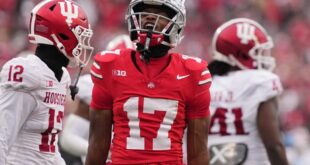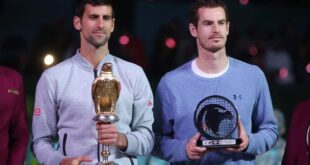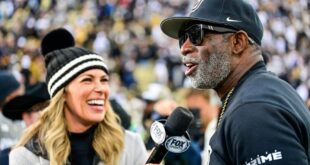LOS ANGELES — Shohei Ohtani strolled into the Los Angeles Dodgers clubhouse about three and a half hours before first pitch, displaying the easygoing demeanor of a kid he once was growing up in Japan. He smiled. He joked with teammates. He appeared completely relaxed, just happy to come to the field to play baseball.
Game 6 of the National League Championship Series awaited. Most of the Dodgers already were in uniform. But no worries for Ohtani. The New York Mets’ starter, left-hander Sean Manaea, had struck him out twice and popped him up in Game 2, prompting Dodgers manager Dave Roberts to say, “I haven’t seen him look that bad against anyone.” But one of Ohtani’s many strengths is that he is utterly secure in his ability and preparation. Not all superstars are that way.
Ohtani, 30, erased any memory of Game 2 with his first at-bat of Game 6, grounding a 2-2 sinker from Manaea up the middle for a single. He added an RBI single off Mets reliever Ryne Stanek in the seventh to improve to 18 for his last 22 with runners in scoring position. And when the Dodgers’ 10–5 victory was complete, he and Roberts poured beer over each other’s head in the clubhouse, celebrating a moment that will elevate the entire sport. Ohtani’s first trip to the World Series.
The Dodgers will face the New York Yankees in a collision of star power: Ohtani, Mookie Betts and Freddie Freeman on one side, Aaron Judge, Juan Soto and Giancarlo Stanton on the other. It’s possible Ohtani might not be the best player on the field. It’s also possible the competition will spur him to even greater heights.
Ohtani might not be Superman, but put a challenge in front of him, and watch him leap it in a single bound. As well as Manaea pitched against the Dodgers in Game 2, it was the first time they faced him with his lower arm slot, and he admitted he hit a wall in the sixth inning. Perhaps Ohtani felt confident things would be different seeing a tiring pitcher a second time in six days. Or perhaps he just knew it would all work out in the end.
This was the script both Ohtani and the Dodgers envisioned when he signed his record 10-year, $700 million free-agent contract in December, with all but $20 million deferred. The deal is virtually certain to prove a bargain. From the money the Dodgers will invest before paying off the bulk of Ohtani’s salaries from 2034 to ‘43. From the 10 sponsorships they secured with Japanese companies. And from the trip to the World Series that Ohtani helped deliver in year one.
“He really was interested in finding a team that he knew wanted to win,” said Mark Walter, the Dodgers’ chairman and controlling owner, in the team’s Champagne-drenched clubhouse. “I really felt we owed him for choosing us, to be the best team we could be.”
Walter and his fellow owners committed another $700 million in player salaries last offseason on top of Ohtani’s $700 million to make that happen, adding Japanese right-hander Yoshinobu Yamamoto, among others. The reason Ohtani deferred money was to give the Dodgers payroll flexibility. Help them build a better team. Reach heights he never approached in six seasons with the Los Angeles Angels. The postseason. The League Championship Series. And now, the World Series.
In his postseason game interview with me on FS1, Ohtani summed it up rather succinctly.
“It’s the place that I’ve dreamt of playing all my life.” 🥹
Shohei Ohtani is going to the #WorldSeries! pic.twitter.com/5B1V9Jee6h
— MLB (@MLB) October 21, 2024
“This is a place that I’ve dreamt of playing all of my life,” he said.
Roberts sat in his office before Game 5, talking with the Fox broadcasters. The Dodgers, leading the Mets, three games to one, were one win away from their first Series appearance since 2020. Roberts spent part of the session fretting over his pitching. But he also could not contain his excitement over the possibility of Ohtani playing in the World Series.
“I want the whole world to see Shohei on the biggest of stages,” Roberts said. “I want that for our game.”
Baseball no longer holds the place in American society it did in the late 1940s and 1950s, when the Yankees and Dodgers (then in Brooklyn) met in the Series five times in eight years. Nor is it as prominent as it was in the late 1970s and early 1980s, when the teams played for the championship three times in five years.
The 2024 Series might not restore the game to what it was. It certainly will not elevate the sport above the NFL. But the presence of Ohtani will pique the curiosity of casual fans in North America and create an outright frenzy among Ohtani’s legion of followers in Japan.
“This is the best thing for our game, to have all these people show interest in this crazy, potentially great Series of two iconic franchises,” Roberts said. “There is not going to be more talent on the field in one Series. For Shohei, this is what he signed on for. For it to play out as such, I’m really excited for him, and for sports fans around the world.”
Some fans of other major-league clubs will roll their eyes over such talk, noting that the Dodgers had the game’s second-highest payroll after the Mets, while the Yankees were third. But while payroll disparity is a legitimate and enduring issue in the sport, big-money teams in recent years routinely have flamed out in the postseason.
Excluding the shortened 2020 season, this Series will feature the teams with the top records in the AL and NL for the first time since the Boston Red Sox defeated the St. Louis Cardinals in 2013. When the Dodgers and Yankees met at Yankee Stadium in June, the baseball was exquisite. And with the World Series not beginning until Friday, injured and tired players on both teams will have time to recover.
Soto, coming off his electrifying three-run homer in the 10th inning of the ALCS clincher, is heading toward a monster free-agent contract. Judge is only 5-for-31 in the postseason, but during the regular season his league-leading 1.159 OPS was 123 points higher than Ohtani’s. Stanton already has hit five home runs in the playoffs, giving him 16 in the postseason for his career.
For the Dodgers, Betts rebounded from his slow start to the postseason by going 7-for-14 with two homers, three double and two walks in the final three games of the NLCS. Freeman, dealing with a severely sprained ankle, is only 7-for-32 (.219) with no extra-base hits in the postseason. But then there is Ohtani, for whom the Mets had no answer.
The question was almost laughable.
“At one point, you were 0-for-22 with no runners on base,” a reporter asked Ohtani in his postgame news conference. “Was there anything you changed with your approach, or did you talk to Doc (Roberts) about moving down in the order … or did you just keep swinging away.”
Ohtani, through his interpreter, Will Ireton, replied, “There’s nothing in particular that I changed. Obviously, when there’s situations, I do change how I swing. But in terms of my approach, I’ve been continuing with my approach the whole time. I do think a part of it is just a small sample size.”
Ohtani’s 18-for-22 blitz with runners in scoring position could be dismissed for the same reason, except it’s probably more reflective of his offensive skill. For the record, Roberts never considered moving Ohtani down in the order. And the 0-for-22 nonsense ended in Game 4 at Citi Field, when Ohtani led off the game with a 117.8 mph homer off Mets lefty Jose Quintana. The home run was the third hardest-hit postseason homer of the Statcast era, which began in 2015. Ohtani then drew walks in his next three plate appearances, and scored each time.
His other homer of the NLCS was a three-run shot in the eighth inning of Game 3, extending the Dodgers’ lead to 7-0 and enabling Roberts to stay away from his leverage relievers in the final two innings. That blast, soaring over the right-field foul pole, prompted a challenge from the Mets. But as the Dodgers’ Max Muncy said, “I don’t know how you would even overturn that. The ball was 100 feet over the foul pole. The foul pole’s not tall enough for that one.”
Ohtani finished the series 8-for-22 with nine walks. His on-base percentage was .548, his OPS 1.185. The Yankees have one left-handed starter, Carlos Rodón, and also could activate another, Nestor Cortes Jr., for the World Series. Tim Hill, the top lefty in their ‘pen, has allowed only three hits to left-handed hitters, all singles, in 13 at-bats this postseason. The Yankees use their other lefty, Tim Mayza, more sparingly. Righty Tommy Kahnle’s excellent changeup, though, makes him a weapon against left-handed hitters. Righty Luke Weaver also has reverse splits.
The next three days will be filled with analysis, hype and the kind of fever the World Series last experienced … well, when exactly? In 2016, when the Chicago Cubs met the then-Cleveland Indians, with both teams trying to end long championship droughts? In 2004, when the Red Sox were seeking to win their first World Series title since 1918?
Nah, the anticipation of this Series will top those, and most others. It’s New York and L.A. It’s the likely MVP in each league. It’s the moment Ohtani has anticipated, Dodgers president Stan Kasten said, “literally his whole life.” The moment, president of baseball operations Andrew Friedman said, that is “exactly what we talked about when we met with him in December.”
Ohtani will stroll into the home clubhouse again on Friday, the little kid all grown up, at the pinnacle of his sport. The tumult around him will be considerable, but in his singularly focused mind, nothing will change. As the World Series begins, Shohei Ohtani will be ready to play another baseball game.
(Top photo of Shohei Ohtani: Photo by Daniel Shirey / MLB Photos via Getty Images)
 meganwoolsey Home
meganwoolsey Home



